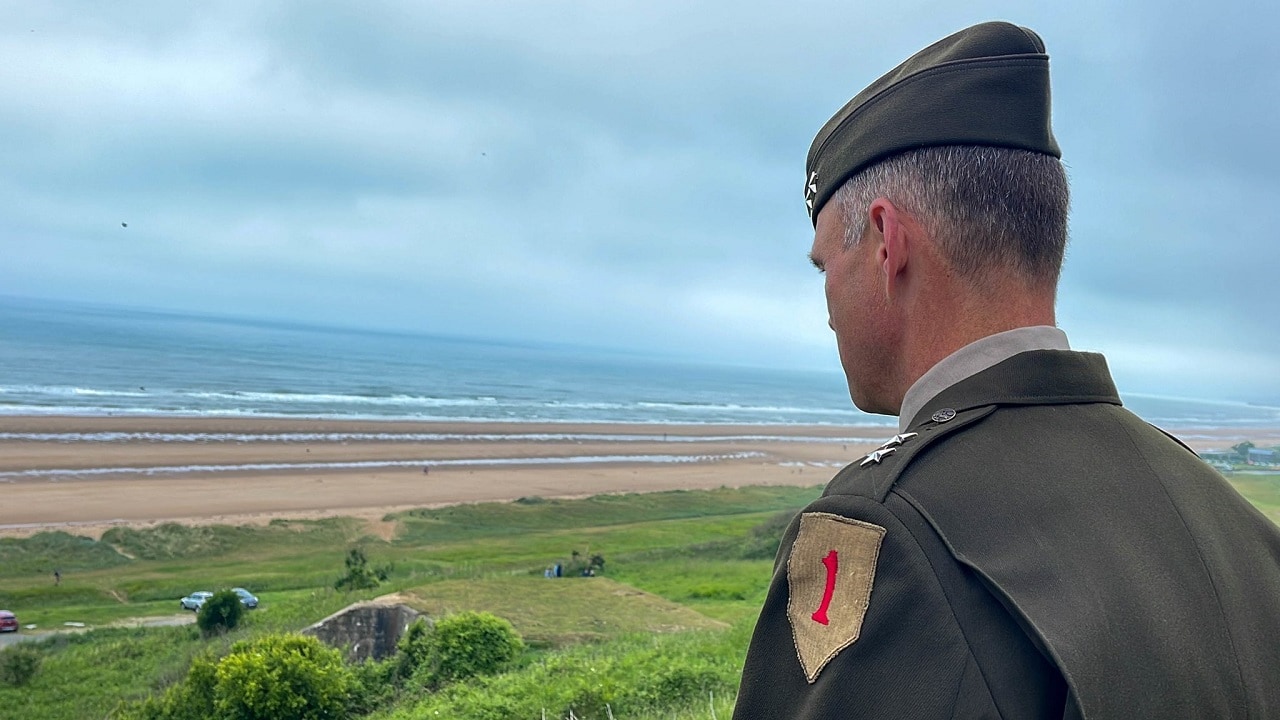In late 2018, the United States Army officially introduced the Army Green Service Uniform (AGSU), which replaced the blue Army Service Uniform (ASU), and it was quickly noted for closely resembling the Army’s World War II officer’s attire. The uniform was dubbed “pink and greens” by service members in the 1940s as the pair of pants often had a pink hue. The AGSU currently consists of a green jacket, khaki (not actually pink) pants, a khaki dress shirt and brown oxford shoes. In addition, soldiers are now supplied matching socks, a tie and garrison cap, the flat and straight-sided foldable hat.
The uniform may resemble what soldiers of the “Greatest Generation” may have worn, but U.S. Army Maj. Gen. John V. Meyer III, the new commanding officer of the Army’s First Infantry Division, will now have the added honor of wearing an actual shoulder patch that was issued during the Second World War and was reportedly worn during the D-Day landings.
According to a post from the unit’s official social media account (@FightingFirst), Maj. Gen. Meyer has become the temporary caretaker of a patch that was worn by former commanders of the division.
“Did you know that the patch on MG Meyer’s shoulder is the same patch from D-Day? It is passed down from commanding general to commanding general. #Normandy,” the First Infantry Division announced via its #TriviaTuesday tweet.
It was on May 11 of this year at the Cavalry Parade Field, Fort Riley, Kansas that the First Infantry Division hosted the division change of command ceremony. It honored the division’s outgoing commanding general, U.S. Army Maj. Gen. D.A. Sims II, and to welcome incoming commanding general, Maj. Gen. Meyer.
“In my 31 years in the Army, I have had no job like this,” said Maj. Gen. Sims, who assumed command of the division and the fort in August 2020. “Removing the Big Red One patch from my left shoulder will be one of the hardest things I’ve had to do, but it’s a bit easier knowing John and Kelley Meyer are here.”
Meyer’s officially assumed command of the division with the passing of the colors, a historic military tradition that demonstrates a symbolic transfer of responsibility to a new leader.
The Big Red One
The First Infantry Division’s insignia – a shoulder patch with a large red number “1” on a khaki field led to the unit’s nickname, the “Big Red One.” It is also one of the most iconic shoulder insignia in the U.S. military.
Initially known as the “Fighting First,” the division was constituted on May 24, 1917, and was among the first units to arrive in France as part of the First Expeditionary Division during the First World War. Yet, the origin of the insignia remains somewhat shrouded in mystery. One popular legend is that the 1st Division’s supply trucks were painted with a large number 1’s on the side to help distinguish them from other units. Some soldiers then took to put a red number one on their sleeves.
Another story is that an officer in the unit felt a shoulder insignia was needed, and he cut a “1” from his flannel underwear. This was later added on top of gray cloth from the uniform of a captured soldier.
Whatever the origin, it stuck and the Big Red One has remained an active unit of the United States Army, and its soldiers are easily recognized by its shoulder insignia.
Now a Senior Editor for 1945, Peter Suciu is a Michigan-based writer who has contributed to more than four dozen magazines, newspapers and websites. He regularly writes about military hardware, firearms history, cybersecurity and international affairs. Peter is also a Contributing Writer for Forbes.

